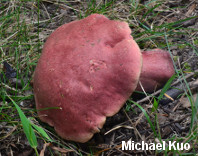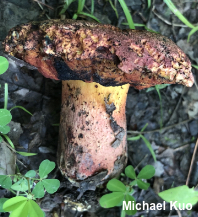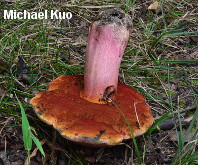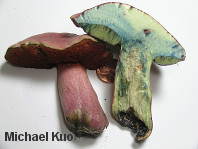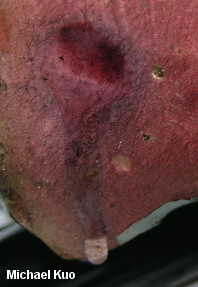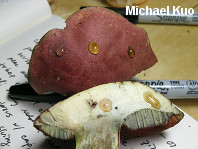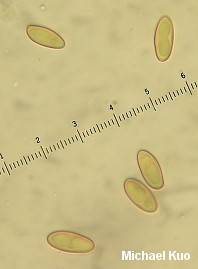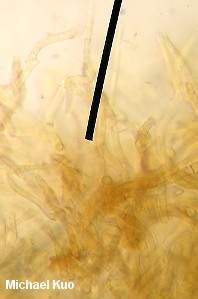| Major Groups > Boletes > Red-Pored Boletes > Boletus rubroflammeus |

|
Boletus rubroflammeus [ Basidiomycota > Boletales > Boletaceae > Boletus . . . ] by Michael Kuo Boletus rubroflammeus is a red-pored, red-capped, blue-staining bolete from eastern North America's hardwood forests. Its stem is beautifully reticulate with a red, net-like pattern, and its cap surface turns fleetingly bluish with strong bases. When young the cap is matted with a grayish material that soon all but disappears, but can sometimes be found along the margin of the mature cap. Look-alike eastern boletes include Boletus flammans (appearing only under conifers), Butyriboletus floridanus (limited to the southeast, mature pore surface more orange, cap not initially matted with grayish material), and Boletus rhodosanguineus (stem more yellow, especially toward base; cap becoming mottled with browns; odor very strong and sickly sweet). Without offering evidence or discussion, Bessette and collaborators (2016) treat Boletus rubroflammeus and Boletus flammans as synonyms—but this is a clear error, in my opinion, given the implausibility of a single mycorrhizal species associating with spruces, eastern hemlock, pines, beech, and oaks. In fact Boletus rubroflammeus was originally separated from Boletus flammans because "the cap is not viscid and it grows in low, moist, rich hardwoods rather than under spruce, hemlock, and white pine mixtures" (Smith & Thiers 1971). Description: Ecology: Mycorrhizal with hardwoods; usually growing alone or scattered; summer; possibly widely distributed east of the Rocky Mountains. The illustrated and described collections are from Illinois and Indiana. Cap: 6–12 cm; convex, becoming broadly convex; dry; finely velvety when very young, but soon bald; purplish red to pinkish red, hardly fading; when young often matted with a grayish material that is sometimes visible along the margin in mature caps. Pore Surface: Dark red at first, but fading somewhat; bruising promptly blue; with 2–3 circular to angular pores per mm; tubes 1–2 cm deep. Stem: 6–8 cm long; 1–3 cm thick; more or less equal; orange-yellow at the apex and the base, especially when young; colored like the cap overall; dry; reticulate with a fine red reticulum over the upper half; bald underneath the reticulum; basal mycelium pale yellow. Flesh: Pale yellow in cap; sometimes with reddish streaks in stem; staining promptly blue when sliced. Odor and Taste: Not distinctive. Chemical Reactions: Ammonia quickly bluish purple, then negative on cap surface; negative to grayish on flesh. KOH flashing blue, then dull orange or yellow on cap surface; dull orange on flesh. Iron salts negative to gray on cap surface; negative on flesh. Microscopic Features: Spores 10–14 x 5–6 µm; boletoid-fusiform; smooth; yellow to dull golden in KOH. Basidia 25–28 x 6–9 µm; clavate; 4-sterigmate. Hymenial cystidia 40–45 x 5–7 µm; narrowly lageniform or fusiform; smooth; thin-walled; hyaline in KOH. Pileipellis a collapsing trichoderm of elements 4–7.5 µm wide, smooth, hyaline to orangish brown in KOH; terminal cells cylindric with rounded (or, rarely, subacute) apices. REFERENCES: Smith & Thiers, 1971. (Smith, Smith & Weber, 1981; Both, 1993; Bessette, Roody & Bessette, 2000.) Herb. Kuo 08239703, 08291404, 06101802. This site contains no information about the edibility or toxicity of mushrooms. |
© MushroomExpert.Com |
|
Cite this page as: Kuo, M. (2020, November). Boletus rubroflammeus. Retrieved from the MushroomExpert.Com Web site: http://www.mushroomexpert.com/boletus_rubroflammeus.html |
